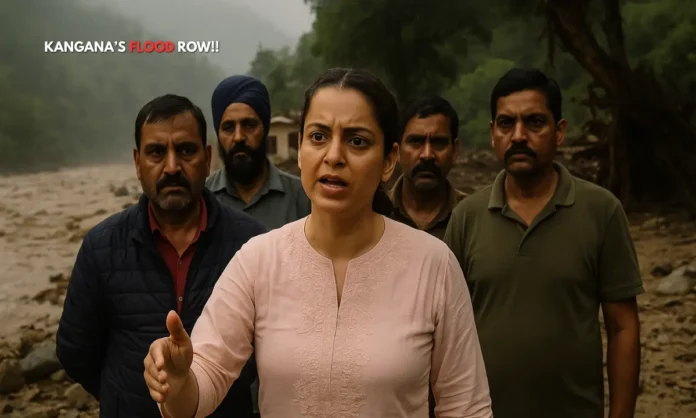Summary
- Kangana Ranaut visited cloudburst-hit Mandi, declaring she has no disaster relief funds or Cabinet power.
- Accused the Congress-led Himachal government of corruption and failing flood victims.
- Visit followed public criticism over her absence as 14 died and 31 remain missing in the district.
A Flood of Accusations in the Hills
As cloudbursts and flash floods wreak havoc in Himachal Pradesh, BJP MP Kangana Ranaut’s visit to her constituency, Mandi, triggered a political deluge of its own. On Sunday, Ranaut appeared on the ground for the first time since the twin cloudbursts that left at least 14 people dead, 31 missing, and scores of families displaced. But it wasn’t her presence—it was her statement—that made headlines. “I do not have any funds for disaster relief or hold any Cabinet post,” she said, in what many interpreted as both an admission and a deflection. Her remarks—couched in helplessness—were accompanied by fierce allegations that the Congress-led state government is hiding behind corruption and negligence.
As rescue efforts continue, and with large swathes of Mandi’s rural infrastructure still reeling, her visit has added a new dimension to an already bitter political blame game. The broader debate isn’t just about who is responsible for aid—but who is visible when it counts.
Kangana today visited the flood affected areas of Mandi #KanganaRanaut pic.twitter.com/BMovWtYykT
— Kangana Ranaut Updates ✨️ (@KanganaUpdates) July 6, 2025
Ground Zero: Wreckage in Mandi
- Over 150 homes, 31 vehicles, and 14 bridges destroyed in a span of hours.
- 200 roads inaccessible; 236 power transformers, 278 water supply lines down.
- 14 confirmed dead, 31 people missing; 164 cattle dead across flood zones.
The fury of Himachal’s monsoon season has once again laid bare the fragility of its mountain towns. Mandi—one of the hardest hit—saw catastrophic cloudbursts and landslides that crippled essential infrastructure and overwhelmed local emergency services. From washed-out bridges to entire homes swallowed by debris, the scale of destruction has reignited questions about state preparedness and ecological vulnerability.
The Himachal Pradesh State Emergency Operation Centre confirmed that the cumulative toll of the disaster includes not just lives lost but a staggering infrastructural collapse. Power and water supply in many areas remained disrupted as of Monday morning. Some families, particularly in inaccessible hilly stretches, still await first contact with rescue workers.
While central forces were mobilized, local government coordination—critics say—lagged far behind the scale of the catastrophe. For many locals, this disaster is just another chapter in a grim monsoon tradition that has never been adequately addressed.
Kangana’s Statement: Blunt Honesty or Political Posturing?
- Claimed “MPs are small in the scheme of things” and can’t offer direct relief.
- Accused Congress of corruption and incompetence in disaster response.
- Asserted BJP would rule Himachal for the next 20 years due to “people’s anger.”
Kangana Ranaut’s visit was meant to quell criticism over her absence—but her remarks may have had the opposite effect. In a highly publicized interaction with ANI, the Bollywood-turned-BJP MP distanced herself from direct responsibility, stating she had neither funds nor executive authority to act. “We are very small in the scheme of things,” she said, while simultaneously accusing the state’s Congress government of corruption and failure to provide any meaningful relief.
While some supporters applauded her honesty, others—including members of her own party—found the timing and tone out of sync with the suffering on the ground. Former Chief Minister Jairam Thakur’s earlier remark—“Cannot comment on those who are not [present]”—seemed like a quiet rebuke to her absence, and her subsequent visit has only magnified intra-party and inter-party tensions.
Her prediction that Congress would not return to power in Himachal “for 20 years” due to the mishandling of the floods struck a clearly political tone. For victims still awaiting basic aid, it was unclear whether the statement reflected political resolve or opportunism.
Politics Amid Ruin: A State on the Edge
- Public anger is rising against both state and central leadership over delayed aid.
- Experts warn that cloudbursts in Himachal are no longer rare anomalies.
- Questions remain about coordination, preparedness, and visible leadership.
Kangana Ranaut’s visit—however belated—has shone a spotlight on a recurring issue: disaster governance in the hills. Every year, Himachal Pradesh suffers extensive losses during the monsoon season, yet few long-term solutions are ever put in place. From underdeveloped early warning systems to bureaucratic delays in releasing relief funds, the state seems caught in a cycle of tragedy and political scapegoating.
While the central government has dispatched NDRF and SDRF teams, critics argue that relief on the ground remains slow and fragmented. Environmental scientists have long warned that the Western Himalayan region, including districts like Mandi and Kullu, is increasingly prone to extreme weather events due to a mix of climate change and unchecked construction.
The absence of proactive coordination between state and central leaders—especially visible in the public finger-pointing—only compounds the suffering. Voters are watching closely: not just to see who visits the site of the disaster, but who brings results in its aftermath.
After the Flood: Visibility, Power, and Responsibility
Kangana Ranaut’s statement—that she is “small in the scheme of things”—may have been an attempt at realism, but it also underscored the growing chasm between political visibility and public accountability. In an era of celebrity-politicians and constant media glare, what the public increasingly demands is not who shows up, but what gets done.
With monsoons expected to intensify year after year, disaster relief in Himachal Pradesh can no longer afford to be an annual ritual of aerial surveys, blame games, and token visits. The Mandi floods of 2025 may well become a political inflection point—but only if they lead to a serious rethinking of ecological planning, intergovernmental coordination, and representative responsibility.


